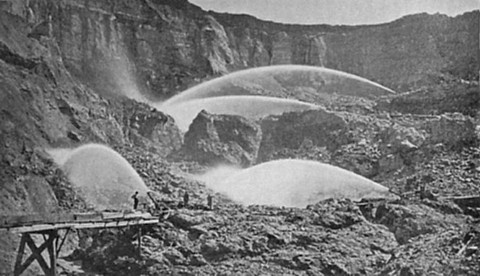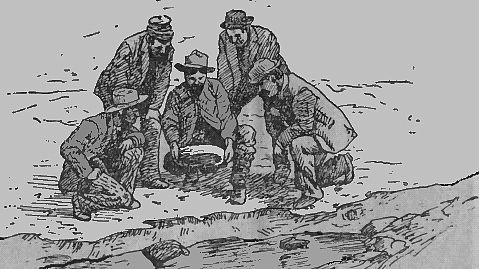Those who found singularly large and valuable nuggets were few as compared with the number who, while locating remunerative claims, took out fortunes from coarse and fine pay dirt. These big nuggets form the theme of anecdote and newspaper record, all with the occasional exaggeration. A great example of this is the prospecting claim on Carson Hill, from which gold was chiseled out in big chunks, and which yielded within a short time some $2,000,000. There are many stories of the treasure troves that were repeatedly obtained by individual diggers, especially in the numerous 'pockets' of the Sonora region, including Woods Creek, the richest of its size, the bars of American, Yuba, and Feather rivers, with such spots as Park Bar, Rush and Nelson creeks, where the yield of one day's work frequently fulfilled the brightest hopes of the gold-hunter. The American Middle Fork yielded perhaps the best steady average of gold dust. All found sooner or later that mining was a lottery, for adjoining claims even in a reputably rich spot might bring to one miner a fortune, to others working nearby, nothing; and the most inexperienced greenhorn might strike a deposit in the most unfavorable place, while experienced diggers toiled in vain.
Gigantic nuggets were a lottery wherein a vast number of blanks were overshadowed by the glitter of the few prizes. The great majority of California gold rush diggers obtained little more than the means to live at the prevailing high prices, and many not even that. At times they might find a remunerative claim, but this was offset by periods of enforced idleness in searching for new ground, by waiting for rains or for the abatement of waters, by more or less extensive preliminary work to gain access to the paying strata and making it available, with the aid of shafts, tunnels, ditches, and so forth. Here are some examples of those fantastic finds and the tales associated with them:
In 1852 a chunk of gold weighing 45 pounds and worth $8,000 was found near Sonora, Tuolumne county, California. The finder had a friend, relates S. M. Frazier in Mining Reporter of Denver, who was far gone in consumption, but who was still trying to work in the mines. The owner of the nugget saw that the man was fast killing himself. At that time such a mass of gold was a curiosity which people would flock to see, and he arranged with his sick friend, who was well educated, to take the nugget to the States for exhibition purposes. Besides the mass of solid gold, he took some fine dust, chispas, gold bearing quartz, black sand, gravel and auriferous dirt from the placer, and delivered lectures on mining operations in California. The agreement between them was that whenever the owner wanted the nugget or its value he was to let his friend know of his need. For a time the miner heard from his friend regularly, then all at once lost track of him. He began after months to think his nugget lost that his friend had been murdered and robbed in some out-of-the-way place. One day, however, a letter reached the miner from a banker in New Orleans, telling him that his friend had died in that city, but had left the big nugget at the bank subject to his order. The miner wrote to have the nugget melted down, and in due time he received a check from the bank for a little over $8,000.
Some years ago a man was literally "kicked" into a fortune. Louis Roderigo was discharged by the superintendent of the Mistle Shaft Mine. Every day for weeks he hung around the mine imploring to be taken back. Finally he was kicked off the grounds. He procured a pick and shovel and grub enough to last him for a week or two, and started off prospecting in Bear Creek on the Pine Ridge, some 75 miles northeast of Fresno. Three weeks later he returned with $9,000 in gold dust, which was panned out in less than a fortnight's actual work.
Among the mining exhibits in the mining department at the World's Fair at Chicago was a nugget of pure gold, found in Alpine county by a young woman. The history of the discovery of this chunk is cherished by every woman in the gold mining regions in California. Harry E. Ellis and his wife went to the State in 1874 from Philadelphia because of Ellis' serious lung trouble. They went to live up in the mountains of Alpine county, miles from any neighbor. They got their livelihood by hunting and cultivating a few acres of land about their lonely cabin. Grizzled old gold miners with their jackasses laden with grimy camp outfits and blankets, came by the Ellis cabin frequently. One of the men lay ill there for several weeks, while he was nursed to health and vigor by the Ellises. The miner told them how they might find recreation and profit in hunting through the canyons and foothills in that region for "pay dirt” and showed them where he believed there were indications of gold-bearing gravel. For days at a time the young husband and wife tramped up and down the gulches in Alpine county, looking for specks of gold, but all without avail. They abandoned seeking riches in the placers, and confined their attention to their little ranch. One afternoon as Mrs. Ellis was driving home the family cow she was seeking stones to throw for the amusement of the dog. She saw in the coarse gravel a dark, dull yellow stone and picked it up. "I knew from the moment I picked it up," says she, "that I had found gold, because it was so heavy, but as I had never seen a real nugget I was afraid my husband would laugh at me." The nugget has never been melted down for its gold, and is still kept for exhibition purposes. It is phenomenally free from any foreign matter and the size of a croquet ball, but very rough and battered by rolling and tumbling in water for ages. Mrs. Ellis got $2,250 for this find. Such is life and luck among the gold hunters of the world.
In 1851, near Knapp’s ranch in Toulumne County a large nugget weighing slightly over 50 pounds was found by a Mr. Strain. When crushed and melted, and yielded $8,500. It was a slab shaped piece of quartz about 14 inches long 9 inches wide at one end and 4 inches at the other. It was found at the side of the small trail which ran up the hill from a gulch. Literally hundreds of miners had walked over it before Strain happened to see it. The pocket or vein from which it had come was diligently searched for by the other miners in the area. Golden lumps containing gold worth a few hundred dollars each were picked up near where it lay, no great pocket or other source was found.
Two nuggets of gold was an unusual large-size were found near Columbia in Toulumne County many years ago. One was the property of a Mr. Virgin and the other miners who were working together found it at Gold Hill. It weighed 360 ounces and was valued at $6,500 it was oblong, was smooth, and was described as looking like a small metallic meteorite. It was found twelve feet below the surface lodged in some red clay. The other large nugget was found by a Frenchman in Spring Gulch it was a globular mass of nearly pure gold, somewhat coated with oxide of iron and was worth over $5,000. The Frenchman who found it was driven insane by the thought of the gold and was sent to the Stockton asylum. The French Council took charge of the nugget and sent the proceeds to the finder's family in France.
A specimen of crystalline gold from the grit mine near Spanish dry diggings in El Dorado County was sent to the Paris exposition in 1878. The nugget weighs more than 201 Troy ounces and was mined from a pocket 200 feet below the surface where it was found together with another 200 or so ounces of crystalline gold. The purchaser of the large nugget, but it sent to Paris was a Mr. Fricot, who had for a time lived in Grass Valley and was lately moved to New York. The nugget was never melted down, and is the largest California gold nugget still in existence.
Another California gold nugget which was exhibited at the Paris exposition of 1878 was a specimen of crystallized gold from the Banghart mine in Mad Mule Canyon of Shasta County. It weighed in at 13 ounces, but on account of its beauty was valued at far more than the metal it contained.


